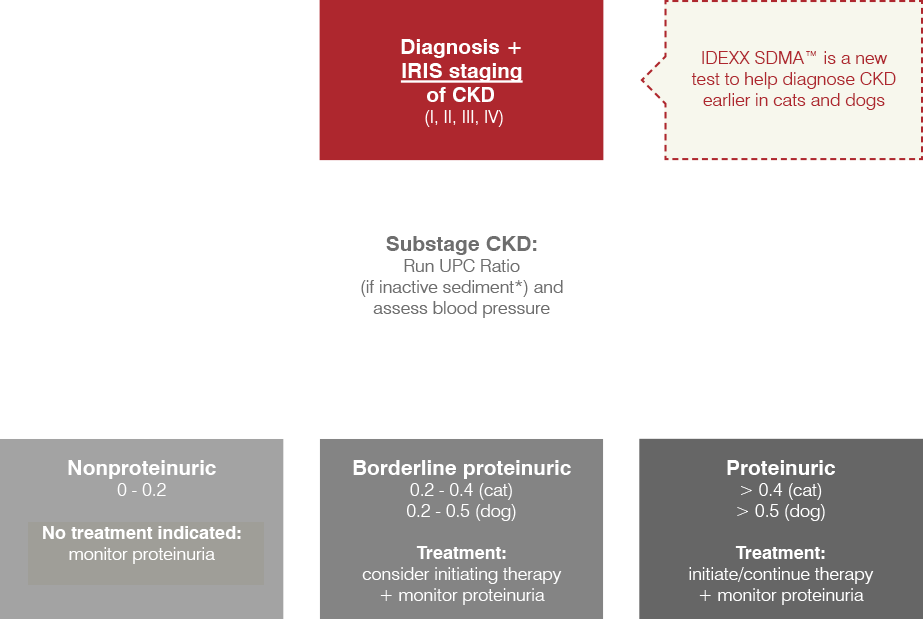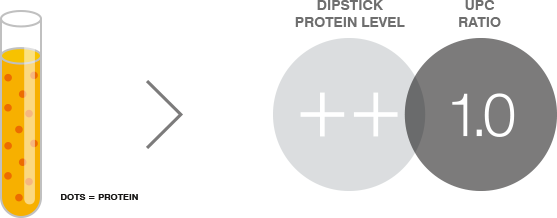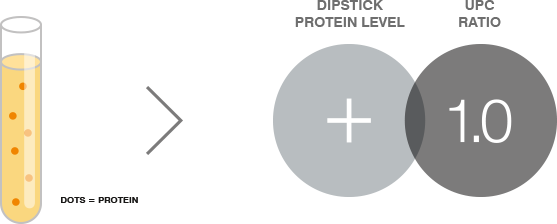
Urine Protein Creatinine Ratio
The test of choice for proteinuria
The UPC ratio provides an accurate and fully quantitative assessment of proteinuria unlike the urine dipstick which is less sensitive and specific for the detection of protein in urine.
Case study: Muriel
9 year old female cat
Muriel presented to the hospital with a history of mild PU/PD, intermittent vomiting which sometimes contains hair, and weight loss.
- Patient: Nine-year-old female cat
- Presenting complaints: Mild PU/PD, intermittent vomiting sometimes containing hair, weight loss
- Physical exam: Moderate dental tartar, unkempt coat, dirty tail (signs of diarrhoea), tachycardia, dry mucous membranes, light skin fold (estimated dehydration: 5% to 7%) and palpable thyroid nodule.
Why UPC
The UPC Ratio is a simple test that measures how much protein is being lost through the kidneys, and determines if the loss poses a health risk for the pet.
Proteinuria is an important concern given its correlation with poor patient outcome. The UPC Ratio has shown a significant correlation with the morbidity of the patient—the higher the UPC ratio value, the worse the prognosis.
The UPC Ratio is the best test available for:
- Detecting proteinuria and measuring persistence and magnitude
- Guiding clinical decisions and monitoring response to therapy
UPC Algorithm
Once an animal has been diagnosed with CKD and staged according to IRIS guidelines, the next step is to substage the dog or cat based on proteinuria and hypertension.

Understanding UPC
The UPC Ratio normalizes urine protein levels for variability in urine concentration.
A CKD patient with good urine concentrating ability:

A CKD patient with loss of concentrating urine ability:

The degree of proteinuria when the animal is first diagnosed with renal disease is helpful in predicting survival time, according to our studies. It’s a gradation; the lower the protein in the urine, the longer the cat is going to survive.
Jonathan Elliott, Vice-Principal (Research and Innovation) Royal Veterinary College, University of London
MA, Vet MB, PhD, Cert SAC, Dip ECVPT, MRCVS
Synopses from the scientific literature
2004 ACVIM Forum Consensus Statement
A great deal of attention has been given to the role of proteinuria in the diagnosis of renal disease.
The leading veterinary experts in Nephrology developed the ACVIM Forum Consensus Statement (Small Animal) on July 28, 2004: “Assessment and Management of Proteinuria in Dogs and Cats”. This 18 page document highlights the most recent research on urine protein and reviews the definition and classification of proteinuria, how it is best to detected and assessed, what the implications are of increased persistent renal proteinuria, when and how to test for proteinuria and how the veterinarian should respond clinically to a finding of proteinuria.
Relation of Survival Time and Urinary Protein Excretion in Cats with Renal Failure and/or Hypertension
The degree of proteinuria is predictive of the survival times in cats with CRF.
In addition to monitoring proteinuria and evaluating the response to therapy, the UPC ratio can be used to determine the approximate survival time of the cat. The higher the level of proteinuria, the shorter the survival time for a given feline patient.
Proteinuria and Renal Disease – A roundtable discussion
This Roundtable is a discussion by the world’s leading experts on renal disease and practitioners discussing kidney disease and proteinuria.
It includes useful information about the prevalence of kidney disease in dogs and cats as well as practical information about diagnosing and treating and monitoring kidney disease in the canine and feline patient.
UPC FAQs
The UPC Ratio is a simple test that measures how much protein is being lost through the kidneys, and determines if the loss poses a health risk for the pet. The test involves measuring the amount of protein and creatinine in a urine sample, and mathematically dividing the protein value by the creatinine value.
The IDEXX UPC Ratio measures urinary protein loss. It can detect very low levels of protein (>5 mg/dL) in canine and feline urine samples. By also measuring urine creatinine levels and forming a ratio of urine protein to urine creatinine, the IDEXX UPC Ratio measures urinary protein loss while automatically correcting for variations in urine volume and concentration.
Creatinine is a by-product of muscle metabolism. Creatinine is excreted in urine at an approximately constant rate, which means it can be used as a standard for comparison for other substances that are also excreted in the urine.
For this test, urine creatinine levels are used to standardize urine protein levels for fluctuations in urine concentration driven by the patient’s level of hydration.
Transient loss of a small amount of protein through the kidneys may not be critical if the kidneys are otherwise working well and producing concentrated urine. However, if kidney function is compromised and the kidneys are producing dilute urine, then even small amounts of urinary protein loss may be abnormal and should be investigated. Substantial and/or persistent protein loss through the kidneys is a concern because it means the kidneys are not working properly. It is also worrisome because the body is losing protein, which is a precious substance needed for long-term health and well-being.
No. Protein can be present in urine if there is inflammation or bleeding anywhere in the urinary system. Protein that comes from inflammation or bleeding is not as worrisome, because the urinary protein loss will stop once the underlying problem is treated or corrected. This is why a urine sediment exam is necessary in conjunction with a UPC Ratio; clean urine sediment is needed to ensure that any subsequent protein detected is of kidney origin.
No. The UPC ratio should be performed only on urine that is free of blood and inflammatory cells. A complete urinalysis and sediment evaluation should be completed to determine if the sample is suitable for the UPC Ratio test. The presence of blood and inflammation in urine may give a falsely high result for the UPC Ratio, suggesting there is kidney disease when none is actually present.
The UPC Ratio must be interpreted in the context of the other kidney function tests like UREA, CREA and SDMA.
We recommend using IRIS guidelines for interpreting UPC Ratio results.
Support
433 10439
Forms & other resources
Access IDEXX Reference Laboratories specimen guidelines, forms, articles, and more.
Test Menu
Browse the Test Menu to see a comprehensive list of offerings from IDEXX Reference Laboratories.
Reference
- Elsemore DA, Geng J, Flynn L, et al. Enzyme-linked immunosorbent assay for coproantigen detection of Trichuris vulpis in dogs. J Vet Diagn Invest. 2014; 26(3):404-411.